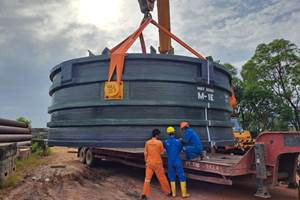Composite stars brighten the holidays
Light, durable design pleases eyes and budget.
T’was the season for such delights.
Designer Stephen Stefanou and his team of artisans and engineers at Venue Arts (Dallas, TX, US) are known for stunning displays at the MGM Macau Resort and Casino (Macau, China) and US destinations, such as New York City’s Rockefeller Center and Bellaggio Las Vegas (Las Vegas, NV). The company also creates unique structures for commercial buildings, product launches and political events. But one of its key markets is holiday installations, at shopping and entertainment centers around the world. Fiber-reinforced plastics (FRPs) are becoming a common construction material for this industry, and they featured prominently in Venue Arts’ creation of the 14-point Moravian stars for Los Angeles, CA, US-based retail complex, The Grove, in anticipation of its 2014 Christmas season.
The Grove project’s design called for an array of Moravian stars covered with mirrored tiles. “The engineering criteria for this project really drove us toward the material,” says Stefanou. “Composites are very stable with respect to thermal expansion,” Stefanou points out, noting that this property was important to project success because, “the location was subject to large swings in temperature from day to night.” Moisture resistance also was key, because winter is Southern California’s rainy season. “These parts are assembled and disassembled every year,” explains Stefanou. “Composites’ stability offers increased longevity, so that the parts continue to fit together and maintain their aesthetics.” He notes that the composites industry itself also played a part in Venue Art’s selection process, because long-time suppliers and new manufacturers are looking for new markets and offering more affordable formats.
Stefanou appreciated the greater flexibility that composites’ high strength, stiffness and low weight offered Venue Arts in its approach to display design and construction. “For example, I am no longer restricted to only hanging the star from its top, but can choose, alternatively, to hang [it] from its side arms,” says Stefanou. “This aids us in designing and implementing installations that meet both aesthetic and cost requirements.”
He points out that the tooling processes proposed by fabrication partner Vectorworks Marine(Titusville, FL, US) also made the project more affordable. “The composition of the display design called for stars of three different heights: 2.7m, 3.7m and 4.2m,” explains Stefanou. Vectorworks used Venue Arts’ 3D computer designs to CNC machine three sizes of plugs, which it used to produce glass fiber composite molds. Vectorworks then used the molds to fabricate the composite parts for each star, which included two three-point pieces, two large points and six small points. Dry E-glass fabrics from Vectorply Corp. (Phenix City, AL, US) and polyvinyl chloride (PVC) foam core from DIAB Americas LP (DeSoto, TX, US) were wet laminated with an Interplastic Corp. (St. Paul, MN, US) vinyl ester resin, then vacuum bagged and consolidated. Although cure was about 30 minutes at room temperature, the parts were typically left overnight before demolding. Each star part was formed from two molded halves, which were bonded together using ACRALOCK methyl methacrylate adhesive from Engineered Bonding Solutions LLC (Titusville, FL, US). Completed star parts were then mechanically fastened to a central steel box (see photo at left) to enable easy disassembly and storage during the off-season.
“Composite materials allow me to work at a larger scale,” Stefanou sums up, “and their light weight and high strength have expanded our design possibilities.”
See a video of The Grove project here.
See links to some of Venue Arts’ other fantastic displays here.
Related Content
Composite SIPs for more affordable, efficient and sustainable buildings
LiteSIP panels and modules enable framing in days, cutting structural labor and total cost by up to 70% and 30%, respectively, while increasing energy efficiency and durability.
Read MoreComposites end markets: Infrastructure and construction (2024)
Composites are increasingly used in applications like building facades, bridges, utility poles, wastewater treatment pipes, repair solutions and more.
Read MoreU.S. grant is awarded for patented SIP composites formwork system
ConTech stay-in-place (SIP) technology, made from recycled composite materials, replaces the use of reinforcing steel in the construction of flat, elevated concrete surfaces.
Read MoreBcomp, Temca achieve intricate composite cladding for French school façade
A combination of flax and glass fibers went into the development of 880 openwork, shade-providing panels for an international school in France.
Read MoreRead Next
Ultrasonic welding for in-space manufacturing of CFRTP
Agile Ultrasonics and NASA trial robotic-compatible carbon fiber-reinforced thermoplastic ultrasonic welding technology for space structures.
Read MoreScaling up, optimizing the flax fiber composite camper
Greenlander’s Sherpa RV cab, which is largely constructed from flax fiber/bio-epoxy sandwich panels, nears commercial production readiness and next-generation scale-up.
Read MoreCutting 100 pounds, certification time for the X-59 nose cone
Swift Engineering used HyperX software to remove 100 pounds from 38-foot graphite/epoxy cored nose cone for X-59 supersonic aircraft.
Read More












